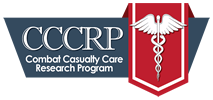 |
| Brain Injury Awareness and CCCRP's State of Technology Meeting | 4/23/2024 |
In honor of the recent Brain Injury Awareness Month in March, the U.S. Army Medical Research and Development Command's Combat Casualty Care Research Program is highlighting a significant achievement within its Neurotrauma Portfolio. Principally striving to "close military-relevant gaps in combat-related traumatic brain injury from the battlefield through acute hospitalization," the Neurotrauma Portfolio is determined to meaningfully advance the TBI space with both knowledge and materiel solutions. Supplementary efforts include the refinement of clinical practice guidelines, the establishment of individualized approaches to casualty management and the oversight of active clinical trials testing several therapeutics for the acute treatment of TBIs, as well as studies developing technologies to noninvasively diagnose, assess and monitor TBI casualties in the far-forward environment.
|
| Full Article Link:
Brain Injury Awareness and CCCRP's State of Technology Meeting |
 |
 |
| Fixing relationships: How US Army Futures Command is working with small biz, academia | 7/25/2019 |
WASHINGTON — U.S. Army Futures Command is laying the groundwork to strengthen collaboration with academia and small businesses to solve some of the service’s most major problems. The Army has struggled with relationships outside of the established defense industry, particularly with small businesses and Silicon Valley. Small businesses have expressed concerns about working with the government, mostly in regard to the time it takes to secure a contract award as well as the complex and cumbersome government-contracting process.
|
| Full Article Link:
Fixing relationships: How US Army Futures Command is working with small biz, academia |
 |
 |
| Robotic surgery training takes on 100th surgical team | 7/24/2019 |
KEESLER AIR FORCE BASE, Miss. -- The Institute for Defense Robotic Surgical Education program celebrated a significant milestone, training the 100th team on robotic surgery at Keesler Air Force Base, Mississippi, on July 23.
This milestone is significant for Keesler’s InDORSE program, showing how far the curriculum has come since the program first stood up in March 2017 with just one robot. Now, InDORSE has acquired a second robot, allowing them to train more military surgical teams across the Department of Defense (DoD), as well as Department of Veteran’s Affairs (VA). |
| Full Article Link:
Robotic surgery training takes on 100th surgical team |
 |
 |
| Clinics, patients turn to hyperbaric medicine | 7/17/2019 |
BROOKE ARMY MEDICAL CENTER, Texas -- “We call it the fog. It's like they’ve been awake for a few days straight,” said Col. (Dr.) Michael Richards, 59th Medical Specialty Squadron Undersea and Hyperbaric Medicine section chief. “His wife had to finish his sentences. He could no longer take care of himself, really. He couldn’t manage his finances, he couldn’t drive, he couldn’t take care of his children. He couldn’t make decisions, even on small things like choosing what kind of milk to buy at the grocery store.”
For this patient, a fighter pilot, suffering from arterial gas embolism, a condition that causes gas bubbles to enter the blood stream and prevent blood flow - “the fog” was a career ender. Or would have been, without the use of hyperbaric medicine. |
| Full Article Link:
Clinics, patients turn to hyperbaric medicine |
 |
 |
| Care in the Air | 6/13/2019 |
SCOTT AIR FORCE BASE, Ill. -- Dangers are always present in today’s world. Whether it is a category 5 hurricane hitting the East Coast leveling everything in its path or an intense fire fight in the heartland of Afghanistan, every day could be someone’s last. However, there is a squadron always ready at a moment’s notice to do whatever it takes to bring someone.
The 375th Aeromedical Evacuation Squadron is one of four active duty AE units in the Air Force comprised of 122 members. Units like the 375th AES are the ones who transport the wounded from the frontlines to higher-stage medical facilities while providing life-saving care at 30,000 feet in the air.
“We are sort of a flying hospital,” said Master Sgt. Angel Curiel, 375th AES Standards and Evaluations flight chief. “We can do medical care on the plane to ensure they are safe, and they are getting everything they need until they can get back to an [higher-stage] hospital on the ground.” |
| Full Article Link:
Care in the Air |
 |

